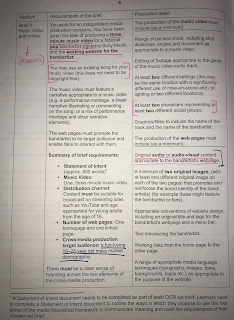THE HISTORY OF MUSIC VIDEOS
Although the origins of the music video dates to ‘Musical short films’ that appeared in the 1920’s. Their prominence in pop culture came from the 1980’s when the channel MTV based their format around this type of medium. Prior to this, videos were described more as an ‘illustrated song’, ‘film insert’ or ‘song video’. Musical films from the 1930’s-1950’s was another important precursor to music video – this was a major inspiration to create videos specifically for music. These music films even became sources of intertextuality, such as ‘Diamonds are a girl's best friend’, from the film ‘Gentlemen prefer Blondes’, which inspired Madonna's ‘material girl’ music video in 1985.
‘Filmed Inserts’
In 1965, British band ‘The Beatles’, began making ‘filmed inserts’ for distribution and broadcast in other countries to promote their record releases without having to make personal appearances. The first promo films were shot in late 1965 – this consisted of ‘Help!’ and ‘We can work it out’ which blended with normal television shows like ‘top of the pops’. Previously, In 1964, Live concert films were already being released with the T.A.M.I show. Bob Dylan’s 1965 promo video for ‘subterranean homesick blues’ is another key video to influence not only modern takes of intertextuality but acted as the precursor of lyric music videos.
At 12:01am on August 1, 1981, history was made when MTV, the first 24-hour video music channel, launched onto our television sets and literally changed our lives with the birth of the music video. The first video ever played on the network was quite ironic — "Video Killed The Radio Star" by The Buggles
In 1983, the most successful, influential and iconic music video of all time was released: the nearly 14-minute-long video for Michael Jackson's song "Thriller", directed by John Landis. The video set new standards for production, having cost US $800,000 to film.
The video for the 1985 Dire Straits song "Money for Nothing" made pioneering use of computer animation and helped make the song an international hit. The song itself was a wry comment on the music-video phenomenon, sung from the point of view of an appliance deliveryman both drawn to and repelled by the outlandish images and personalities that appeared on MTV. In 1986, Peter Gabriel's song "Sledgehammer" used special effects and animation techniques developed by British studio Aardman Animations. The video for "Sledgehammer" would go on to be a phenomenal success and win MTV awards.
Since 2005, the rise of YouTube has seen music videos as some of the highest viewed videos of all time with Luis Fonsi’s reggaeton hit Despacito being the biggest global megahit. The song went to number one in 47 countries and made the top 10 in a further six. It became the first Spanish-language record to go to number one in the U.S. since Macarena back in 1996.The song also set a record for the fastest song to reach one billion views, taking just 97 days. In comparison, it took Gangnam Style five months to achieve the same landmark.
Subscribe to:
Post Comments (Atom)
BRIEF NUMBER 4
For my media project I have chosen to make a music video for a ‘fictional pop artist’ as well as the ‘artists’ working website. As part o...

-
STATEMENT OF INTENT Brief: Music video and online website How do you intend to use the four areas of the media theor...
-
The term convergence describes things coming together. cross - media convergence is the merging of mass communication outlets including p...
-
EDITING Throughout the editing process, I used Adobe Premier pro to construct my music video. I found this a grea...


No comments:
Post a Comment